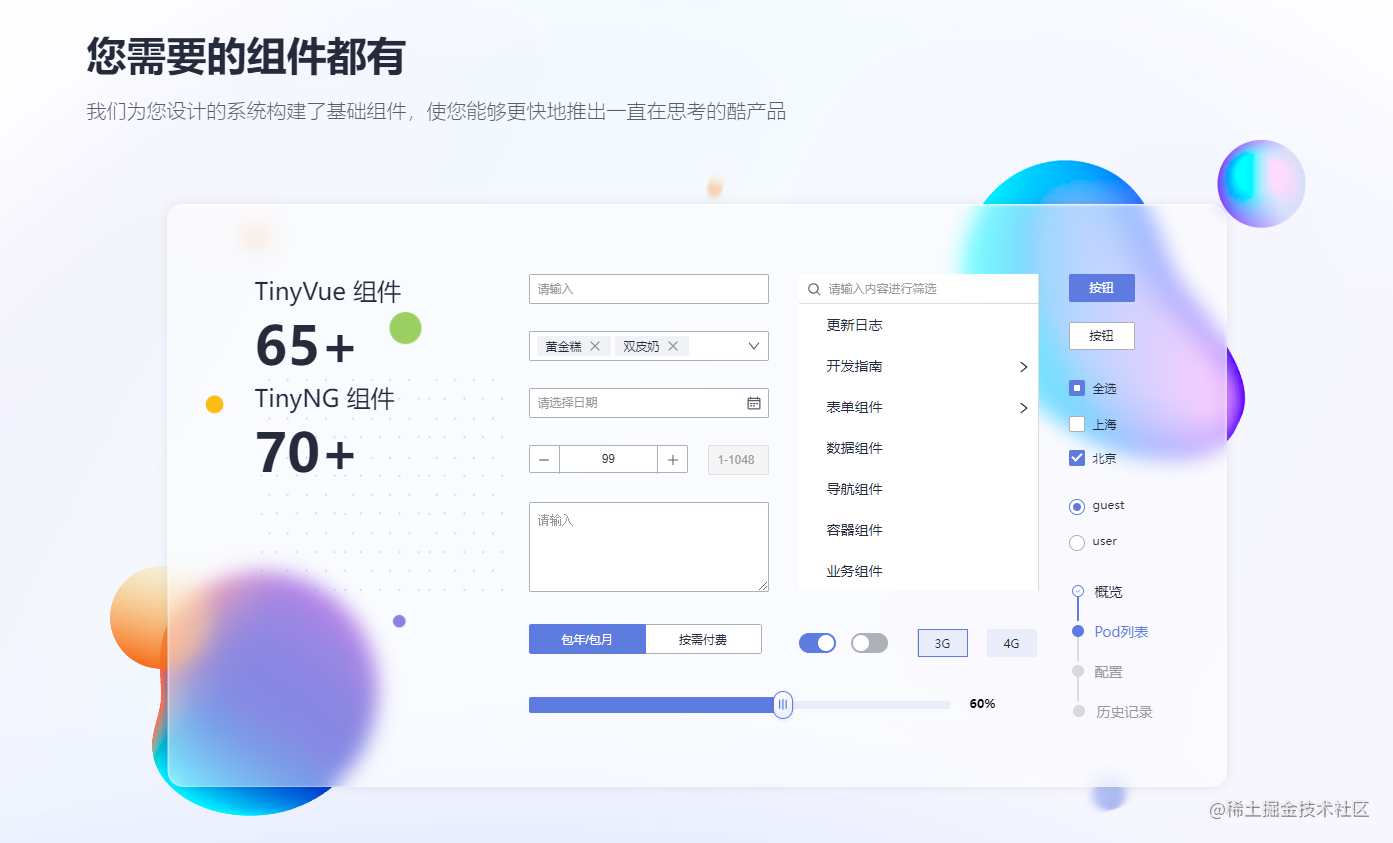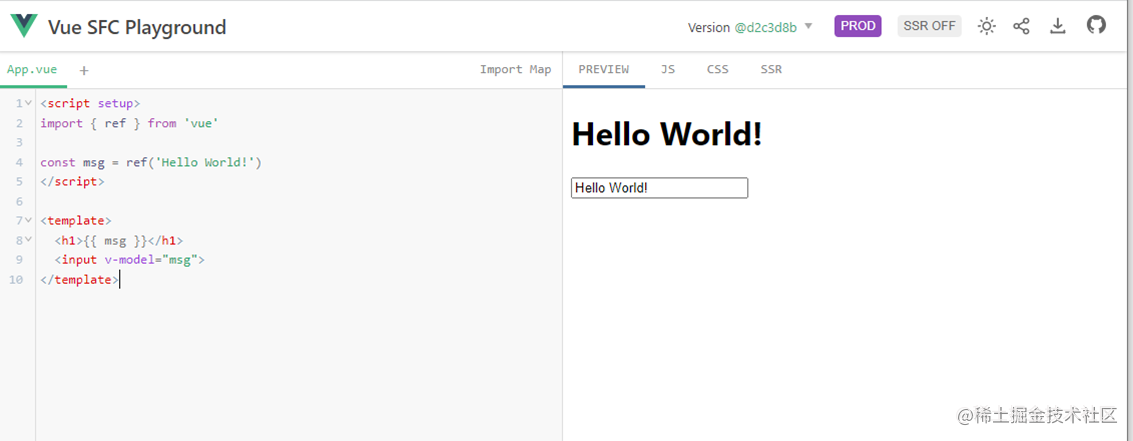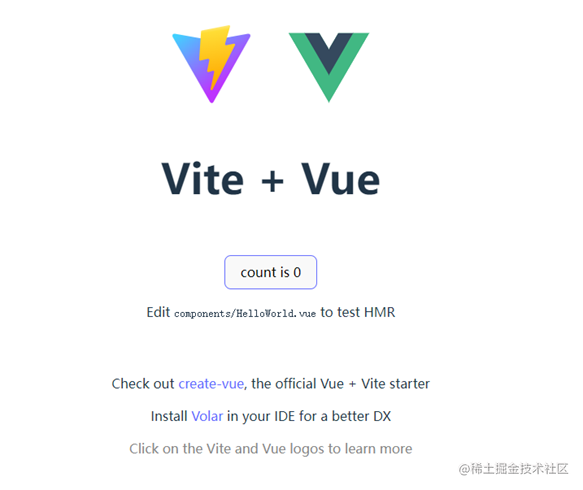1 知识背景
1.1 Vue框架
一个渐进式框架,它易学易用,性能出色,在国内推广最好的三大前端框架中,位居首位!
1.2 OpenTiny组件库
它在华为内部演进了9年,支撑了上千个项目的开发交付,它一套API同时支持Vue2和Vue3框架,有100 多个组件,6套主题,支持国际化能力,支持Vite和webpack环境的开发和构建!
它是华为云的2022年贡献给开源社区的一个新的Vue UI组件库,代码托管在GitHub: https://github.com/opentiny/tiny-vue, 欢迎大家来Star 和提Issue!
安装包发布在Npm 公共仓库,以及华为内部中心仓,遵从MIT开源协议,大家可以自由安装使用!
Opentiny组件库官网文档:https://opentiny.design/tiny-vue

图1 opentiny介绍
1.3 组件库的playgroud
Playground应用其实是一个实时的组件预览页面,比如Vue官网就提供了“Vue演练场”的功能,链接:https://play.vuejs.org/ ,它方便的提供了一个最小的Vue环境,能让用户尝试写一些Vue的代码,并查看实时预览结果!

图2 Vue官方playground效果图
它支持多文件,支持 Import Map 引入第三方组件脚本,支持实时编辑代码,实时编译、预览以及代码分享!组件库的Playground就是要搭建一个应用页面,可以实时预览某个组件库的组件,可以通过它快速了解和尝试每一个组件!
Vue 官方开源的Playground的组件—@vue/repl,参考文档:https://github.com/vuejs/repl#readme 。
2 如何搭建OpenTiny组件库的playground的指导
今天的内容就是:搭建一个OpenTiny组件库的演练场。本次任务需要你熟悉前端,有Vue项目开发的经历才行。完成效果图如下:

图3 挑战任务示意图
请参考以下步骤来完成此次任务:
2.1 建立新项目,并安装依赖包
安装nodejs 16+ , vscode等前端工具,然后使用 vite 来创建一个vue的javascript工程!
npm create vite@latest
之后安装Playground的组件和opentiny/vue组件的依赖包
npm install @vue/repl @opentiny/vue@3
并务必参考opentiny/vue的安装文档, https://opentiny.design/tiny-vue/zh-CN/os-theme/docs/installation 进行配置项目。
目前大家已经有一个标准的vue项目了,经过npm intall, 之后,就可以npm run dev,启动并看到一个vue的示例工程。

图四 vue的新工程初始页面
2.2 创建页面结构,引入所需要的变量
接下来删除掉 HelloWorld.vue ,在main.js中, 移除style.css引用,我们只在App.vue中完成全部功能!App.vue的页面结构如下:
<script setup>
import {
reactive } from 'vue';
import {
Repl, ReplStore, File } from '@vue/repl'
import CodeMirror from '@vue/repl/codemirror-editor'
import '@vue/repl/dist/style.css'
import {
Switch as TinySwitch, ButtonGroup as TinyButtonGroup, Select as TinySelect, Option as TinyOption, Modal } from '@opentiny/vue'
import {
IconShare as TinyIconShare } from "@opentiny/vue-icon"
// 将在此处补充逻辑代码
</script>
<template>
<div>将在此处补充模板代码</div>
</template>
<style>
* {
box-sizing: border-box;}
.header {
height: 36px;
display: flex;
flex-direction: row;
justify-content: space-between;
padding-bottom: 6px;
border-bottom: solid 1px #e1e1e1;
}
.vue-repl {
height: calc(100vh - 36px - 16px) !important;}
.header > div {
vertical-align: middle;}
.title {
font-size: 20px;}
.ml20 {
margin-left: 20px;}
</style>
2.3 开发顶部功能
应用的模板分为上下2部分,上面部分为标题Logo和一组选择功能以及分享按钮!下面部分就是一个<Repl> 组件。我们先开发顶部功能,它的<template>代码如下:
<div class="header">
<div class="title">
<img src="./assets/opentiny-logo.svg" /> <span>OpenTiny Vue 演练场</span>
</div>
<div>
<span class="ml20">
显示编译输出: <tiny-switch v-model="state.showCompileOutput" />
</span>
<span class="ml20">
显示ImportMap: <tiny-switch v-model="state.showImportMap" />
</span>
<span class="ml20">
布局方向: <tiny-button-group :data="state.layoutOptions" v-model="state.layout"></tiny-button-group>
</span>
<span class="ml20">
版本: <tiny-select v-model="state.selectVersion" style="width:150px">
<tiny-option v-for="item in state.versions" :key="item.value" :label="'opentiny/vue@' + item.value"
:value="item.value">
</tiny-option>
</tiny-select>
</span>
<icon-share style="font-size: 16px;margin:0 20px; cursor: pointer;" />
</div>
</div>
模板里已经绑定了一组数据和方法,接下来,我们需要补充这些内容到<script>部分。
const iconShare = TinyIconShare()
const state = reactive({
// repl 属性
showCompileOutput: true,
showImportMap: true,
layout: 'horizon',
layoutOptions: [{
value: 'horizon', text: "水平" }, {
value: 'vertical', text: "垂直" }],
// 版本切换
versions: [{
value: "3.8.0" }, {
value: "3.8.1" }, {
value: "3.8.2" }, {
value: "3.8.3" }, {
value: "3.8.4" }],
selectVersion: "3.8.4"
})
至此,我们应该能得到以下应用,顶部的显示开关和布局方向绑定了3个变量,但是版本选择和分享的功能还没有开发!

图五 顶部功能效果图
★ 经过本步骤,我们学会了@opentiny/vue的组件的简单使用方法!
2.4 开发<Repl>组件,实现脚本预览
首先在模板中,引入Repl标签,并且绑定前面的3个变量以及ReplStore 变量。在 header 结构下面加入下面标签:
<Repl :store="store" :editor="CodeMirror" :show-compile-output="state.showCompileOutput" :show-import-map="state.showImportMap"
:previewOptions="state.previewOptions" :clear-console="false" :layout="state.layout"></Repl>
这里用到store变量和state.previewOptions, 所以在<script>部分,增加这些2处变量:
// repl组件需要store管理状态
const store = new ReplStore({
showOutput: true,
outputMode: "preview"
});
const state = reactive({
// 加入这一句
previewOptions: {
headHTML: '' },
})
此时我们就得到一个可以联动的playground的原型了:在右边编写代码,在左边有实时预览,操作顶部的功能,区域有响应,界面如下:

图六 组件效果图
★ 经过本步骤,我们学会了的组件使用方法!
2.5 实现切换版本
切换版本就是要切换repl组件引用的importMap的脚本,以实现动态切换@opentiny/vue的版本。 目前它发布了 3.8.0~3.8.4等5个版本!在<script>中,加以下脚本 :
const createImportMap = (version) => {
return {
imports: {
"@opentiny/vue": `https://unpkg.com/@opentiny/vue@${
version}/runtime/tiny-vue.mjs`,
"@opentiny/vue-icon": `https://unpkg.com/@opentiny/vue@${
version}/runtime/tiny-vue-icon.mjs`,
"@opentiny/vue-locale": `https://unpkg.com/@opentiny/vue@${
version}/runtime/tiny-vue-locale.mjs`,
"@opentiny/vue-common": `https://unpkg.com/@opentiny/vue@${
version}/runtime/tiny-vue-common.mjs`
}
}
};
function versionChange(version) {
const importMap = createImportMap(version)
store.setImportMap(importMap);
state.previewOptions.headHTML = `<link rel="stylesheet" href="https://unpkg.com/@opentiny/vue-theme@${
version}/index.css">`
}
我们编写了versionChange函数,把它绑定到前面模板的的 change事件上,这样下拉变化后,会通知store设置新的importMap地址!
现在切换版本后,通过开发者工具能看到,它会立即请求相应版本的@opentiny/vue的各个runtime脚本包。
★ 经过本步骤,我们学会了Tiny-Select的组件的事件绑定以及设置store的importMap变量!
2.6 实现代码分享
Repl组件是支持代码分享的,它的原理是:store对象把内部状态序列化为base64编码,把它拼在url的hash中分享给其它人。 当页面加载时,发现hash有内容,就知道这是store的状态,把它传给store,store内部会进行反序列化。
我们应用分享的时候,要记录组件库版本号和store状态,所以我们计划用hash同时保存版本和base64的值: 3.8.4|eNqIVV9p…
const hash = location.hash.slice(1)
// shareData数组如果有2项,则表明是分享链接,否则是非分享页面
const shareData = hash.split('|')
const store = new ReplStore({
// 添加下面一行
serializedState: shareData.length == 2 ? shareData[1] : '',
showOutput: true,
outputMode: "preview"
});
const state = reactive({
// 修改下面这一行
selectVersion: shareData.length == 2 ? shareData[0] : "3.8.4"
})
// 分享链接和非分享链接的逻辑不同,此处判断一下
if (shareData.length == 2) {
versionChange(shareData[0])
} else {
versionChange('3.8.4')
}
// 生成分享链接
function share() {
const hash = store.serialize().slice(1)
const shareUrl = location.origin + '#' + state.selectVersion + '|' + hash
navigator.clipboard.writeText(shareUrl);
Modal.alert(`已复制分享链接`, '分享成功')
}
把share函数绑定给模板中的分享图标的click事件,这样点击图标,就能把链接复制到剪切板中了, 再打开一个新页签,访问分享链接。
在分享链接中打开的新页面,当前hash就有一个很长的字符串了,这样shareData就解析到版本和store序列化的后值,所以把shareData[1]的内容赋值给store, 这样就实现了分享功能,试一下能不能成功吧!
★ 经过本步骤,我们学会了分享功能的设计以及store的序列化!
2.7 测试@opentiny/vue组件库
下面是一个@opentiny/vue组件库的使用示例,复制到应用窗口,并修改脚本,验证功能是否正确。点击分享按钮,并复制到其它页签,看是否分享内容了。
<script setup>
import {
reactive } from "vue"
import {
Button as TinyButton, Alert as TinyAlert, Numeric as TinyNumeric, Slider as TinySlider, Select as TinySelect, Option as TinyOption, Modal } from "@opentiny/vue"
const state = reactive({
value: 42,
selectValue: "",
options: [
{
value: '选项1', label: '黄金糕' },
{
value: '选项2', label: '双皮奶' },
{
value: '选项3', label: '蚵仔煎' },
{
value: '选项4', label: '龙须面' },
{
value: '选项5', label: '北京烤鸭' }
],
})
function showValue() {
Modal.alert(`当前值: ${
state.value} \n 当前下拉框值: ${
state.selectValue}`, '标题')
}
</script>
<template>
<div class="mb20">Alert 演示</div>
<div class="mb20">
<tiny-alert description="type 为默认值 success"></tiny-alert>
<tiny-alert type="error" description="type 为 error"></tiny-alert>
<tiny-alert type="info" description="type 为 info"></tiny-alert>
<tiny-alert type="warning" description="type 为 warning"></tiny-alert>
</div>
<div class="mb20">组件 演示</div>
<div class="mb20">
<tiny-numeric v-model="state.value"></tiny-numeric>
<tiny-slider v-model="state.value"></tiny-slider>
下拉选择框:<tiny-select v-model="state.selectValue" placeholder="请选择">
<tiny-option v-for="item in state.options" :key="item.value" :label="item.label" :value="item.value"> </tiny-option>
</tiny-select>
</div>
<div>
<tiny-button @click="showValue">显示当前值</tiny-button>
</div>
</template>
<style>
div .tiny-select {
width: 200px;
}
.mb20 {
margin-bottom: 20px;
}
</style>
关于 OpenTiny
OpenTiny 是一套华为云出品的企业级组件库解决方案,适配 PC 端 / 移动端等多端,涵盖 Vue2 / Vue3 / Angular 多技术栈,拥有主题配置系统 / 中后台模板 / CLI 命令行等效率提升工具,可帮助开发者高效开发 Web 应用。
核心亮点:
跨端跨框架:使用 Renderless 无渲染组件设计架构,实现了一套代码同时支持 Vue2 / Vue3,PC / Mobile 端,并支持函数级别的逻辑定制和全模板替换,灵活性好、二次开发能力强。组件丰富:PC 端有80+组件,移动端有30+组件,包含高频组件 Table、Tree、Select 等,内置虚拟滚动,保证大数据场景下的流畅体验,除了业界常见组件之外,我们还提供了一些独有的特色组件,如:Split 面板分割器、IpAddress IP地址输入框、Calendar 日历、Crop 图片裁切等配置式组件:组件支持模板式和配置式两种使用方式,适合低代码平台,目前团队已经将 OpenTiny 集成到内部的低代码平台,针对低码平台做了大量优化周边生态齐全:提供了基于 Angular + TypeScript 的 TinyNG 组件库,提供包含 10+ 实用功能、20+ 典型页面的 TinyPro 中后台模板,提供覆盖前端开发全流程的 TinyCLI 工程化工具,提供强大的在线主题配置平台 TinyTheme
联系我们:
- 官方公众号:
OpenTiny - OpenTiny 官网:opentiny.design/
- OpenTiny 代码仓库:github.com/opentiny/
- Vue 组件库:github.com/opentiny/ti… (欢迎 Star)
- Angluar组件库:github.com/opentiny/ng (欢迎 Star)
- CLI工具:github.com/opentiny/ti… (欢迎 Star)